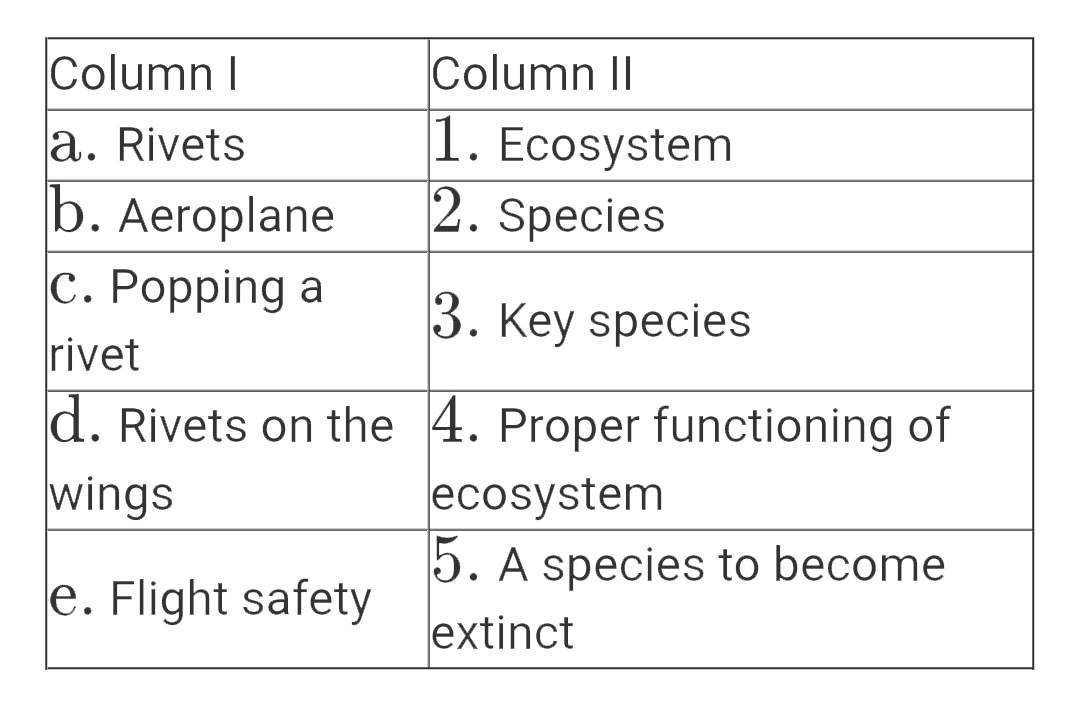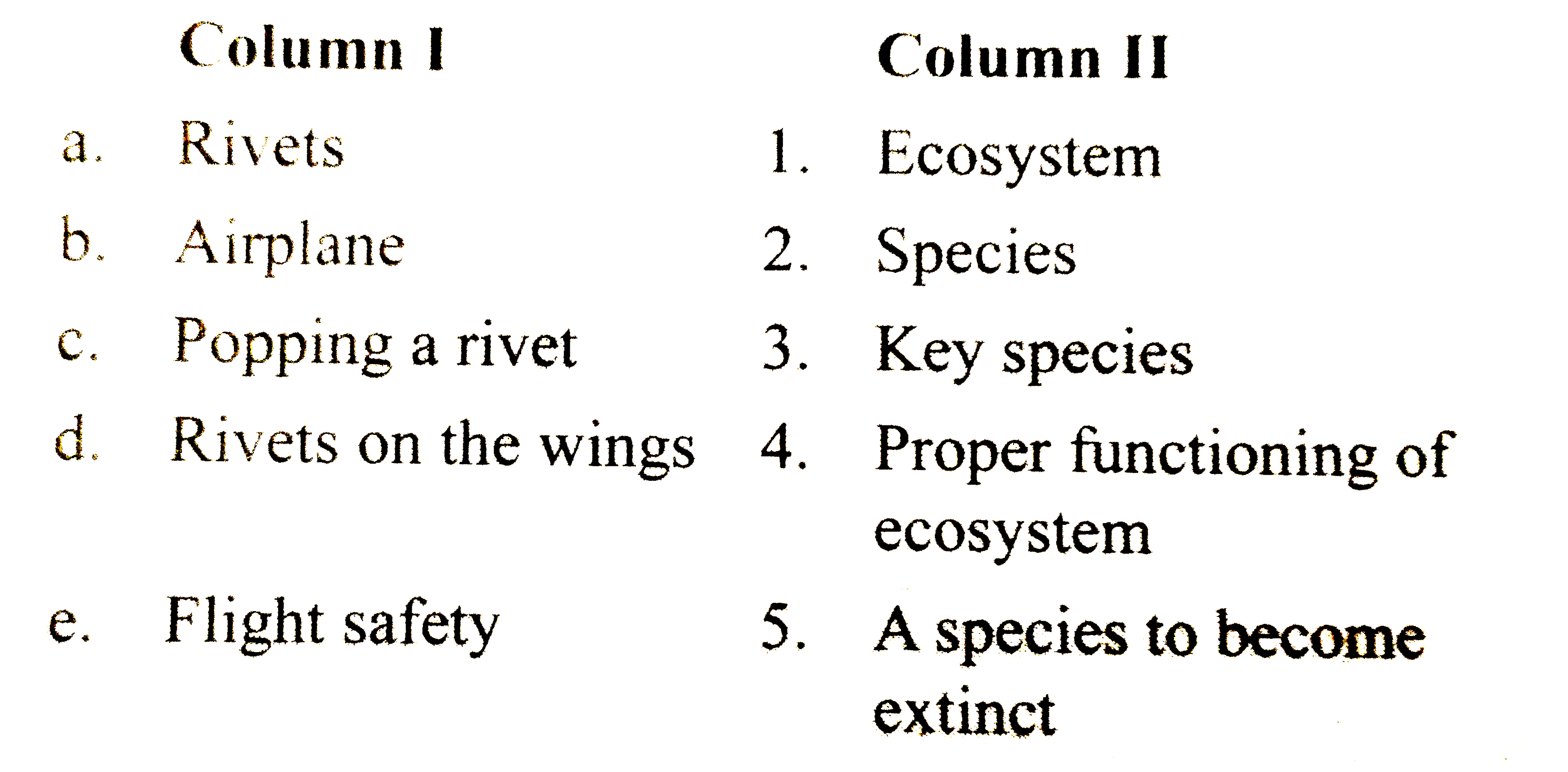Describe rivet popper hypothesis.
Rivet popper hypothesis is used as an analogy by Stanford ecologist Paul Ehrlich comparing ecosystem to an airplane where in, all parts are joined together using thousands of rivets (species). Initially popping a rivet (causing a species to become extinct), may not affect flight safety i.e., proper functioning of the ecosystem. But as more and more rivets are removed, the plane becomes dangerously weak over a period of time. Removal of specific rivet becomes critical-especially on the wings (key species that drive major ecosystem functions) and a more serious threat to flight safety than loss of a few rivets on the seats or windows inside the plane.
Topper's Solved these Questions
- II PUC BIOLOGY (P.U. BOARD LATEST MODEL QUESTION PAPER - 1)BOOK - SUNSTAR PUBLICATIONCHAPTER - II PUC BIOLOGY (P.U. BOARD LATEST MODEL QUESTION PAPER - 1)EXERCISE - PART - D (Section - I)
10 Videos
- II PUC BIOLOGY (P.U. BOARD LATEST MODEL QUESTION PAPER - 1)BOOK - SUNSTAR PUBLICATIONCHAPTER - II PUC BIOLOGY (P.U. BOARD LATEST MODEL QUESTION PAPER - 1)EXERCISE - PART - D (Section - II)
12 Videos
- II PUC BIOLOGY (P.U. BOARD LATEST MODEL QUESTION PAPER - 1)BOOK - SUNSTAR PUBLICATIONCHAPTER - II PUC BIOLOGY (P.U. BOARD LATEST MODEL QUESTION PAPER - 1)EXERCISE - PART - B
9 Videos
- ANNUAL EXAM QUESTION PAPER MARCH -2020BOOK - SUNSTAR PUBLICATIONCHAPTER - ANNUAL EXAM QUESTION PAPER MARCH -2020EXERCISE - PART D (SECTION - II)
7 Videos
- II PUC BIOLOGY (P.U. BOARD LATEST MODEL QUESTION PAPER - 2)BOOK - SUNSTAR PUBLICATIONCHAPTER - II PUC BIOLOGY (P.U. BOARD LATEST MODEL QUESTION PAPER - 2)EXERCISE - PART - D (Section - II)
9 Videos
Similar Questions
Knowledge Check
Choose the incorrect statement about the rivet popper hypothesis .
AConscious extinction of species through the loss of biodiversity is more harmful than natural extinction.BThe species which goes extinct affects the functioning of the ecosystemCExtinction of species will not affect the proper functioning of the ecosystem initially, but it becomes dangerous over time.DIn his hypothesis , Stanford ecologist Paul Ehrlich compared the ecosystem to an ironclad ship with the species as the ship's rivets.In a comparative analogy between the aeroplane and ecosystem (the rivet popper hypothesis) used by Paul Ehrlich, find out the correct matching .
 Aa−1,b−2,c−3,d−4,e−5Ba−2,b−1,c−4,d−5,e−3Ca−2,b−1,c−5,d−4,e−3Da−2,b−1,c−5,d−3,e−4
Aa−1,b−2,c−3,d−4,e−5Ba−2,b−1,c−4,d−5,e−3Ca−2,b−1,c−5,d−4,e−3Da−2,b−1,c−5,d−3,e−4In a comparative analogy between the airplane and ecosystem (the 'rivet popper hypothesis) used by Stanford ecologist Paul Ehrlich, find out the correct matching.
 Aa-1, b-2, c-3, d-4, e-5Bs-2, b-1, c-4, d-5, e-3Ca-2, b-1, c-4, d-5, e-3Da-2, b-1, c-5, d-3, e-4
Aa-1, b-2, c-3, d-4, e-5Bs-2, b-1, c-4, d-5, e-3Ca-2, b-1, c-4, d-5, e-3Da-2, b-1, c-5, d-3, e-4
According to rivet popper hypothesis, if ecosystem is considered as airplane then what does the rivets on wings represent.
View SolutionIn a comparative analogy between the aeroplane and ecosystem (the rivet popper hypothesis) used by Paul Ehrlich, find out the correct matching .

(a) a−1,b−2,c−3,d−4,e−5
(b) a−2,b−1,c−4,d−5,e−3
(c) a−2,b−1,c−5,d−4,e−3
(d) a−2,b−1,c−5,d−3,e−4
View SolutionFill in the blanks with suitable words w.r.t. Rivet popper hypothesis.

View SolutionFill in the blanks with suitable words w.r.t. Rivet popper hypothesis.

View SolutionAssertion : According to rivet popper hypothesis, loss of rivets on the wings is obviously a more serious threat to flight safetyl than loss of a few rivest on the seats or windows inside the plane.
Reason : Which rivet is removed from the airplane may also be ciritical.
View Solution
